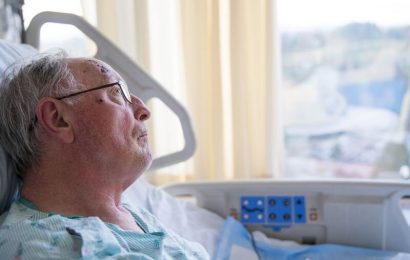Women who lose or gain weight around their middle in the year after breast cancer surgery may double the risk of tumours returning
- A total of 1,317 women with breast cancer were analysed for weight changes
- Those with oestrogen receptor (ER) positive breast cancer saw their risk go up
- Tumours can be stimulated to grow by the hormone oestrogen
- However, risk of cancer recurrence lowered in ER negative breast cancers
Women who lose or gain weight around their middle in the year after breast cancer surgery may double their risk of tumours returning, research suggests.
The study of women with ER positive breast cancer found those whose body shape remained stable did not face recurrence rates as high.
Up to 80 per cent of breast cancers are ER positive, meaning that they contain proteins called oestrogen receptors.
Tumours are stimulated to grow by the hormone oestrogen, which is secreted by fat cells. This may explain why weight gain causes the cancer to return.
However, it is not clear why losing body fat also contributes to an increased risk of cancer returning.
On the back of the findings, experts said more research is needed to understand the role of fat tissue in cancer.
The research in Sweden also looked at women with ER negative breast cancer, and found changes in stomach fat lowered the odds of recurrence risk.

Women who lose or gain weight around their middle in the year after breast cancer surgery may double their risk of tumours returning (stock)
Breast cancer is the UK’s most common cancer, with around 55,000 women and 370 men being diagnosed each year, and around 11,500 women dying.
It is not uncommon for weight to be gained during or after breast cancer treatment for several reasons.
These include diets or tastes changing, steroids being given with chemotherapy, the menopause being brought on by treatments, or people being less active than usual when having or recovering from treatment.
The latest study was presented at the UK Interdisciplinary Breast Cancer Symposium in Birmingham by oncologists Professor Helena Jernstrom and Helga Tryggvadottir.
HOW CAN OBESITY CAUSE CANCER – INCLUDING BREAST?
Obesity and being overweight is the second biggest preventable cause of cancer in the UK- more than one in 20 cancer cases are caused by excess weight, according to Cancer Research UK.
Around 12 per cent of women who are obese will develop breast cancer compared to nine per cent who are of a healthy weight range, Breast Cancer Now states.
This higher risk is because fat cells make oestrogen, and excess oestrogen in the body drives cancer. It can make hormone-receptor-positive breast cancers develop and grow.
After the menopause, the ovaries stop producing oestrogen, so levels in the body drop. But women who are overweight or obese after the menopause are more likely to be exposed to oestrogen created by their fat cells.
Being overweight or obese also alters the levels of other hormones, including insulin, which regulates the amount of sugar in your blood. Higher insulin levels have also been linked to some cancers, including breast cancer.
Generally, obesity is also often associated with an unhealthy lifestyle – eating junk food and not getting enough fruit, vegetables or exercise – factors which are separate but linked and also known to increase the risk of cancer.
A total of 1,317 women with primary breast cancer in Sweden between 2002-2014, were analysed.
Researchers at Lund University gathered patients’ body size measurements at surgery and one year after.
Waist-hip ratio (WHR) is a proxy measure for fat on the abdomen and is defined by the circumference of a person’s waist divided by circumference at their widest hip point.
The World Health Organisation recommends that a woman’s WHR is less than or equal to 0.85.
Participants were assigned to one of four groups depending on whether their WHR changed in the first year following surgery.
These were; a change from above 0.85 to less than or equal to 0.85, a change from less than or equal to 0.85 to above 0.85, remained stable at above 0.85 or remained stable at less than or equal to 0.85.
At a median follow-up of five years, 165 out of 1,317 women experienced a recurrence of their breast cancer. Seventy-seven women died.
The analysis found women with ER positive breast cancer who changed WHR were twice as likely to see their cancer return, compared to women whose WHR remained the same.
Changes in WHR was linked to a seven-fold reduction in risk in those with ER negative tumours, the research suggests.
The team said their findings are the first to show that changes in body shape in the first year after surgery may affect patients’ outcomes differently.
But they cautioned that further studies are needed to validate their findings, published in journal Cancer Causes and Control.
Professor Jernstrom and Ms Tryggvadottir said: ‘This study is the first suggesting that changes in waist-hip ratio during the first year after surgery impact the risk of breast cancer recurrence differently.
‘Our study also emphasises the importance of considering women’s body constitution in making decisions about their treatment and care.
‘As well as changes in body shape being linked to recurrence risk, we also found that a stable weight was associated with a better clinical outcome than substantial changes in body weight.’
The higher risk of breast cancer recurrence with weight gain may be because fat cells make oestrogen, and excess oestrogen in the body drives tumour growth in hormone-receptor-positive breast cancers.
The researchers did not offer an explanation for why weight loss also raised the odds of cancer returning.
Dr Kotryna Temcinaite, research communications manager at Breast Cancer Now, which is hosting the symposium, said: ‘Fat tissue has many different roles in our body.
‘It influences the levels of different hormones including oestrogen, but it can also be involved in processes like inflammation – and different changes can happen throughout the body when the levels of fat change significantly.
‘We now need further studies to understand how the processes that fat tissue is involved in may affect the risk of breast cancer recurrence, and which ones might have the biggest impact.’
The researchers said further studies into the long-term impacts of weight loss on the risk of recurrence are ‘imperative’ before it is recommended to all overweight patients.
Baroness Delyth Morgan, chief executive at Breast Cancer Now, said: ‘We’d urge women not to be unduly worried by these results.
‘Thanks to decades of progress in research and care, most women will not see their breast cancer return.’
Weight is a crucial factor for assessing cancer risk, because being overweight is a driving factor for breast cancer.
Data suggests 12 per cent of obese women will get breast cancer, compared to nine per cent of those in a healthy weight range.
The risk is particularly high after going through the menopause. This is because oestrogen naturally drops after the age of around 55, but fat cells keep the hormone raised.
Only last month, a study found overweight middle-aged women who lose weight are much less likely to get breast cancer – even if they put some back on.
Scientists from the American Cancer Society found women who lost at least 20lbs (9kg) were 26 per cent less likely to develop the killer disease.
The researchers said their findings suggest it’s ‘not too late’ to prevent breast cancer if a woman has put on some weight from the age of 50.
WHAT IS BREAST CANCER, HOW MANY PEOPLE DOES IT STRIKE AND WHAT ARE THE SYMPTOMS?

Breast cancer is one of the most common cancers in the world. Each year in the UK there are more than 55,000 new cases, and the disease claims the lives of 11,500 women. In the US, it strikes 266,000 each year and kills 40,000. But what causes it and how can it be treated?
What is breast cancer?
Breast cancer develops from a cancerous cell which develops in the lining of a duct or lobule in one of the breasts.
When the breast cancer has spread into surrounding breast tissue it is called an ‘invasive’ breast cancer. Some people are diagnosed with ‘carcinoma in situ’, where no cancer cells have grown beyond the duct or lobule.
Most cases develop in women over the age of 50 but younger women are sometimes affected. Breast cancer can develop in men though this is rare.
Staging means how big the cancer is and whether it has spread. Stage 1 is the earliest stage and stage 4 means the cancer has spread to another part of the body.
The cancerous cells are graded from low, which means a slow growth, to high, which is fast growing. High grade cancers are more likely to come back after they have first been treated.
What causes breast cancer?
A cancerous tumour starts from one abnormal cell. The exact reason why a cell becomes cancerous is unclear. It is thought that something damages or alters certain genes in the cell. This makes the cell abnormal and multiply ‘out of control’.
Although breast cancer can develop for no apparent reason, there are some risk factors that can increase the chance of developing breast cancer, such as genetics.
What are the symptoms of breast cancer?
The usual first symptom is a painless lump in the breast, although most breast lumps are not cancerous and are fluid filled cysts, which are benign.
The first place that breast cancer usually spreads to is the lymph nodes in the armpit. If this occurs you will develop a swelling or lump in an armpit.
How is breast cancer diagnosed?
- Initial assessment: A doctor examines the breasts and armpits. They may do tests such as a mammography, a special x-ray of the breast tissue which can indicate the possibility of tumours.
- Biopsy: A biopsy is when a small sample of tissue is removed from a part of the body. The sample is then examined under the microscope to look for abnormal cells. The sample can confirm or rule out cancer.
If you are confirmed to have breast cancer, further tests may be needed to assess if it has spread. For example, blood tests, an ultrasound scan of the liver or a chest x-ray.

How is breast cancer treated?
Treatment options which may be considered include surgery, chemotherapy, radiotherapy and hormone treatment. Often a combination of two or more of these treatments are used.
- Surgery: Breast-conserving surgery or the removal of the affected breast depending on the size of the tumour.
- Radiotherapy: A treatment which uses high energy beams of radiation focussed on cancerous tissue. This kills cancer cells, or stops cancer cells from multiplying. It is mainly used in addition to surgery.
- Chemotherapy: A treatment of cancer by using anti-cancer drugs which kill cancer cells, or stop them from multiplying
- Hormone treatments: Some types of breast cancer are affected by the ‘female’ hormone oestrogen, which can stimulate the cancer cells to divide and multiply. Treatments which reduce the level of these hormones, or prevent them from working, are commonly used in people with breast cancer.
How successful is treatment?
The outlook is best in those who are diagnosed when the cancer is still small, and has not spread. Surgical removal of a tumour in an early stage may then give a good chance of cure.
The routine mammography offered to women between the ages of 50 and 70 mean more breast cancers are being diagnosed and treated at an early stage.
For more information visit breastcancercare.org.uk or www.cancerhelp.org.uk
Source: Read Full Article


